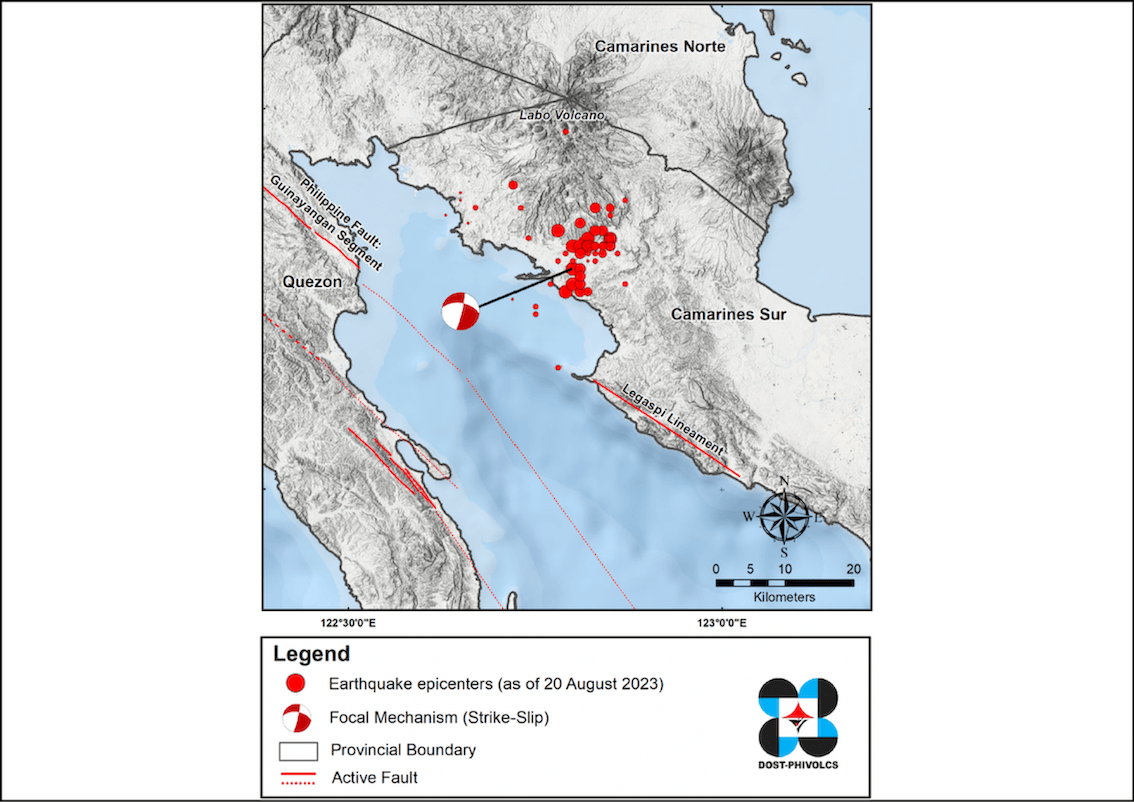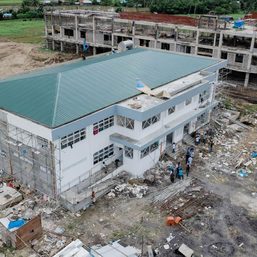SUMMARY
This is AI generated summarization, which may have errors. For context, always refer to the full article.

MANILA, Philippines – The municipality of Ragay in the province of Camarines Sur is experiencing an earthquake swarm that started on Saturday, August 19, according to the Philippine Institute of Volcanology and Seismology (Phivolcs).
“An earthquake swarm is defined as a short-lived sequence of minor to light earthquakes, showing no identifiable large event or main shock,” Phivolcs explained on Sunday, August 20, adding that it may “vary in duration and outcome.”
The agency had plotted 45 earthquakes as of 3 pm on Sunday, with 34 of these felt.
So far, the highest magnitude was 4.4, felt at Intensity V in Ragay. Intensity V is considered strong, with ground shaking “generally felt by most people” and hanging objects swinging “violently.”
“The ongoing cluster of earthquakes is caused by a strike-slip fault, a fault with dominant horizontal movement,” Phivolcs said.
Aside from ground shaking, landslides and rockfalls are possible in mountainous areas, and liquefaction “may affect low-lying, water-saturated, and sandy areas” near bodies of water. During liquefaction, sediments “behave like liquid, similar to quicksand.”
Phivolcs advised people in affected communities to protect themselves from strong quakes by following the standard “drop, cover, and hold” practice, and to secure heavy furniture, appliances, and hanging objects.
It also called on local authorities to inspect buildings and infrastructure for signs of damage.
Ragay is home to 59,770 people, based on the 2020 census.
What could happen next?
State volcanologists are seeing two scenarios for the Ragay earthquake swarm.
First, it may just be a “short-duration burst of earthquake activity,” like the earthquake swarms in Camarines Sur on December 13, 1993, and October 14 to 16, 2021.
Second, the earthquakes “may be a precursor to a larger magnitude earthquake.”
Phivolcs noted that Camarines Sur is a “seismically active region” because of active faults, including the Legaspi Lineament and offshore segments of the Philippine Fault in the Ragay Gulf.
“Other local faults in close proximity might exist, and some of them could potentially be concealed by recent deposits. These concealed faults have the potential to generate minor to strong earthquakes,” added the agency.
A destructive tsunami is not expected since the epicenters of the earthquakes are inland, but there may be “localized sea-level disturbances…as a result of extreme ground shaking resonating along bays,” Phivolcs also said.
Meanwhile, the earthquake swarm is unrelated to volcanic activity, since it is “clearly tectonic in origin.”
“The closest volcano, Labo Volcano, is approximately 15 kilometers away, and is considered potentially active. The nearest active volcano is Isarog Volcano, situated around 60 kilometers away,” Phivolcs added.
Records show that at least seven major earthquakes, ranging from magnitude 6.0 to 7.4, have affected Ragay and its vicinity since 1811.
Phivolcs said the most damaging was the magnitude 7.0 Ragay Gulf earthquake generated by the Guinayangan Segment of the Philippine Fault on March 17, 1973. It was felt at a maximum intensity of VIII, or very destructive, and left 14 people dead. – Rappler.com
Add a comment
How does this make you feel?



![[WATCH] Rappler Live Jam: dwta](https://www.rappler.com/tachyon/2024/07/live-jam-1280-baba.jpg?resize=257%2C257&crop=179px%2C0px%2C1080px%2C1080px)






There are no comments yet. Add your comment to start the conversation.